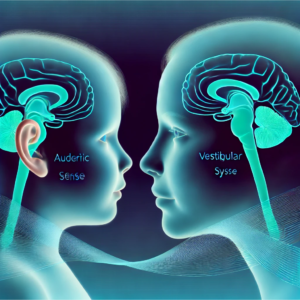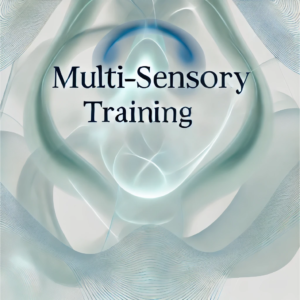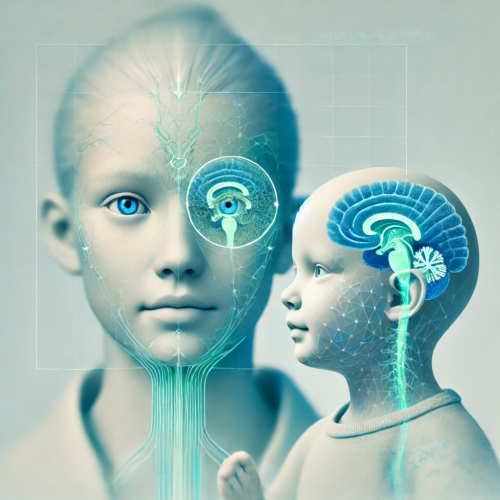Improving Executive Functioning and Learning
At Neuroceptive Learning, we offer advanced solutions to optimise sensory integration. Sensory integration is the process by which the nervous system receives, organises, and interprets sensory information from the environment and the body. It influences our neuroceptive evaluation, determining how our ANS regulates our physical and psychological health and enables us to respond appropriately to stimuli and engage with others and our environment. It influences our Ontology: who we are – our doing, being, becoming, and belonging; our ability to connect to our soul values; and our experience of psychological safety within our environment.
One of our key offerings is Multi-Sensory Training (MST), a powerful intervention designed to help the brain relearn multi-sensory processing – the brain’s first phase of all learning. MST involves retraining the vestibular-auditory-visual triad, often referred to as our “learning triangle”:
- Visual Retraining: This helps restore the client’s receptivity and visual field by exposing them to each part of the visual colour spectrum. Clients are exposed to frequencies of magenta, ruby, red, yellow, green, blue-green, and violet light pulses via a custom-designed computerised light instrument.
- Balance/Vestibular Stimulation: Motion-based activities are conducted through a custom-designed motion table to improve balance, body awareness, and spatial orientation. This stimulates the vestibular, proprioceptive, and tactile senses, promoting somatosensory integration.
- Auditory Retraining: This enhances auditory processing within the human voice range.
The vestibular-auditory-visual triad provides stability and safety to the newborn as their nervous system matures and neural pathways to higher cortical areas of the brain are formed. This foundational development enables future learning, upright posture within gravity, and executive functioning—a concept neuroscientist A. Jean Ayres calls gravitational security.
The pioneering work of Dr Jeremy Schmahmann and Dr A. Jean Ayres indicates that dysfunction of the vestibular-cerebellum can cause us to lose not only our physical balance but also our emotional equilibrium, our ability to learn new skills, regulate emotion, and sustain focus. Dr Schmahmann refers to the universal cerebellar transform (UCT) as an “oscillation dampener,” meaning it works to diminish erratic fluctuations in our thinking, feeling, and behaviour.
Stephen Porges, known for the Polyvagal Theory, also emphasises the role of the acoustic transfer function of middle ear structures and their ability to dampen acoustic frequencies outside the band associated with vocalisations of the human voice. It is within this frequency band that social communication, connection, and co-regulation occur.
Their work suggests that the inner ear and vestibular system play significant roles in conditions such as ADHD, dyslexia, vestibular-associated sensory therapy (VAST), and an array of other conditions, including anxiety, head injuries, learning difficulties, sensory sensitivities, and chronic physical conditions. Children and adults with problems in auditory processing may also have limitations in behavioural state regulation.
Therefore, the MST system, by optimising the integration of the vestibular-auditory-visual triad, re-establishes our learning triangle, improves our gravitational security, normalises our neuroception and ANS regulation, enhances our ontology and experience of psychological safety, and thus may improve our overall health, well-being, and functioning within the world.
MST is a 30-hour programme conducted over 12 consecutive days, followed by an 18-day home practice. The benefits of MST are wide-ranging and impactful. By improving sensory integration, MST can lead to:
- Enhanced Cognitive Functioning: Better focus, memory, and learning capabilities.
- Improved Emotional Regulation: Greater ability to manage stress and emotional responses.
- Better Motor Coordination: Enhanced balance, movement, and physical performance.
- Increased Overall Well-being: A more integrated sensory system contributes to better health and quality of life.
- Normalisation of Neuroception and ANS Regulation: Improved internal evaluation of safety and autonomic nervous system regulation for better health and well-being.
At Neuroceptive Learning, we are dedicated to helping you achieve optimal sensory integration through our MST programme. We were the first provider of the Sensory Learning Program (SLP) of the Sensory Learning Institute (https://www.sensorylearning.com/) in Europe and are now affiliated with and provide the enhanced Multi-Sensory Training of Eyelux Integrations (http://www.mst4brains.com) in Europe.
We combine our other regulatory solutions with the MST programme to ensure you get the most out of your MST training.
To find out more, please contact us.



